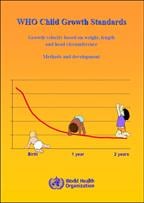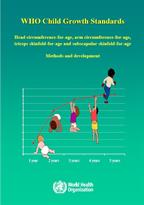Child growth standards
Publications and peer-reviewed articles
The articles and documents listed below can be accessed, downloaded for personal use, or ordered.
Because of copyright arrangements some of the article links may, however, be not freely accessible.
The HINARI program, set up by WHO together with major publishers, enables developing countries to gain access to one of the world's largest collections of biomedical and health literature.
To check the group of countries that may register for access to the journals through HINARI please click on the link below.

WHO child growth standards: growth velocity based on weight, length and head circumference: methods and...
In 1993 the World Health Organization (WHO) undertook a comprehensive review of the uses and interpretation of anthropometric references. The review concluded...
WHO child growth standards and the identification of severe acute malnutrition in infants and children
The statement presents the recommended cut-offs, summarizes the rationale for their adoption and advocates for their harmonized application in the identification...
The Training Course on Child Growth Assessment is a tool for the application of the WHO Child Growth Standards. It is intended primarily for health care...

WHO child growth standards: head circumference-for-age, arm circumference-for-age, triceps skinfold-for-age...
In 1993 the World Health Organization (WHO) undertook a comprehensive review of the uses and interpretation of anthropometric references. The review concluded...
WHO child growth standards: length/height-for-age, weight-for-age, weight-for-length, weight-for-height...
In 1993 the World Health Organization (WHO) undertook a comprehensive review of the uses and interpretation of anthropometric references. The review concluded...
Physical status: the use of and interpretation of anthropometry, report of a WHO expert committee
Anthropometry provides the single most portable, universally applicable, inexpensive and non-invasive technique for assessing the size, proportions and...
An evaluation of infant growth
In preparation for the WHO Expert Committee meeting on Physical Status: the use and interpretation of anthropometry, a Working Group on Infant Growth...
Peer-reviewed articles
- Successive 1-Month Weight Increments in Infancy
The Journal of Nutrition, October 2015 (doi: 10.3945/jn.115.211896) - Parental height and child growth from birth to 2 years in the WHO Multicentre Growth Reference Study
Maternal and Child Nutrition 2013, 9 (suppl. 2). - Worldwide implementation of the WHO Child Growth Standards
Public Health Nutrition, 2012. - Defining obesity risk status in the general childhood population: Which cut-offs should we use?
International Journal of Pediatric Obesity 2010;5:458-60. - Development of a WHO growth reference for school-aged children and adolescents
Bulletin of the World Health Organization 2007;85:660-7. - Symposium: A new 21st-century international growth standards for infants and young children
Journal of Nutrition 2007;137:142-3. - Comparison of the WHO Child Growth Standards and the CDC 2000 Growth Charts
Journal of Nutrition 2007;137;144-8. - Field-testing the WHO Child Growth Standards in four countries
Journal of Nutrition 2007;137;149-52. - Evaluation of the feasibility of international growth standards for school-aged children and adolescents
Journal of Nutrition 2007; 137; 153-7 - Comparison of the World Health Organization (WHO) Child Growth Standards and the National Center for Health Statistics/WHO international growth reference: implications for child health programmes
Public Health Nutrition 2006;9:942-7. - Acta Paediatrica supplement on the WHO Child Growth Standards
Acta Paediatrica Supplement 2006;95:5-101. - Construction of the World Health Organization child growth standards
Statistics in Medicine 2006;25(2):247-65. - Socioeconomic predictors of unconstrained child growth in Muscat, Oman
Eastern Mediterranean Health Journal 2004;10:295-302. - The WHO Multicentre Growth Reference Study (MGRS): Rationale, planning, and implementation
Food and Nutrition Bulletin 2004;25(supplement 1):S3-S84. - Growth charts for breastfed babies
Jornal de Pediatria 2004;80:85-7. - Worldwide practices in child growth monitoring
Journal of Pediatrics 2004;144;461-5. - Factors associated with unconstrained growth among affluent Ghanaian children
Acta Paediatrica 2004;93:1115-9. - The Centers for Disease Control and Prevention 2000 growth charts and the growth of breastfed infants
Acta Paediatrica 2003;92:413-9. - Growth of healthy infants and the timing, type, and frequency of complementary foods
American Journal of Clinical Nutrition 2002;76:620-7. - Growth performance of affluent Indian children is similar to that in developed countries
Bulletin of the World Health Organization 2002;80:189-95. - A new international growth reference for young children.
Dordrecht, The Netherlands: Kluwer Academic Publishers, 2001;45-53. - Growth patterns of breastfed infants in seven countries
Acta Paediatrica 2000;89:215-22. - Infant and young child nutrition: the WHO Multicentre Growth Reference Study
Geneva: World Health Organization, 1999. - A new international growth reference for young children
American Journal of Clinical Nutrition 1999;70(1 Part 2):169S-72S. - The NCHS reference and the growth of breast- and bottle-fed infants
Journal of Nutrition 1998;128:1134-8. - Time for a new growth reference
Pediatrics 1997; 100(5):E8. - The WHO Growth Chart: historical considerations and current scientific issues
Bibliotheca Nutritio et Dieta 1996;53:74-89. - Anthropometric reference data for international use
American Journal of Clinical Nutrition 1996;64:650-8. - An evaluation of infant growth
Bulletin of the World Health Organization 1995;73:165-74. - Growth of breast-fed infants deviates from current reference data
Pediatrics 1995;96:495-503.
